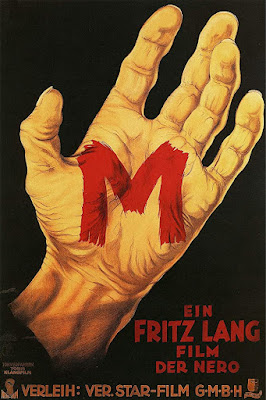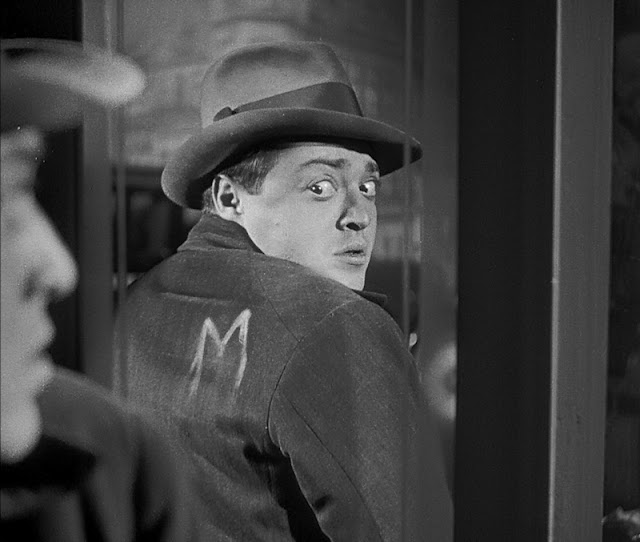(1931) Directed by Fritz Lang; Written by Thea von Harbou and Fritz Lang; Starring: Peter Lorre, Ellen Widmann, Inge Landgut, Otto Wernicke, Theodor Loos, and Gustaf Gründgens; Available on Blu-ray and DVD
Rating: *****
“I have to roam the streets endlessly, always sensing that someone’s following me. It’s me! I’m shadowing myself! Silently… but I still hear it! Yes, sometimes I feel like I’m tracking myself down. I want to run – run away from myself! But I can’t! I can’t escape from myself! I must take the path that is driving me down, and run and run down endless streets! I want off! And with me run the ghosts of the mothers and children. They never go away. They’re always there! Always!” – Hans Beckert (Peter Lorre)
If first impressions are the most crucial, Peter Lorre’s debut in M (minus a couple of minor movie roles) set the tone for his entire film career. Because of that seminal early role and his distinctive (some might say “unconventional”) appearance, he was frequently cast as the antagonist in subsequent movies (The Man Who Knew Too Much, Mad Love, etc…). Being typecast as a horror actor became a boon and a curse to the Austro-Hungarian immigrant, who spent most of his professional life attempting to dispel certain notions about his offscreen persona.* It’s a bit of cruel irony, considering that Lang cast Lorre in the role of serial child killer Hans Beckert because he seemed so non-threatening and unassuming.
* Fun Fact #1: In one interview, Lorre glibly responded to filmgoers’
perceptions of his off-screen persona: “I am afraid that I must disappoint you.
I know what you expected of me, what you hoped of me. So many people have… You
would like me to tell you that I sleep in a darkened room, inhabited, perhaps,
by bats and evil spirits, lit with a red lamp, the evil eye. You would like me
to say that I’m familiar with visitations from another world, that I spend my
days and nights reading ancient tomes of old evils, that I am drenched in the
lives of murderers and mental criminals. No. I am sorry. I am afraid that I am
a very normal, happy, wholesome individual, with no complexes.” (Motion
Picture and Silver Screen, February 1935)
For his first sound picture (filmed 19 months after 1929’s The Woman in the Moon), Fritz Lang* collaborated with screenwriter (and wife) Thea von Harbou, fashioning a story that could have emerged from the newspaper headlines. They were inspired, in part by the exploits of notorious mass murderers Peter Kürten (the “Vampire of Düsseldorf) and Fritz Haarmann (whose macabre story was depicted in 1973’s Tenderness of the Wolves). M ** touched a nerve when it was thrust upon an audience that was already familiar with the real-life atrocities of Kürten, Haarmann, and others.
* Fun Fact #2: Lang, who had been one of German silent cinema’s foremost filmmakers, was reluctant to make the leap to talkies. The resulting film was 2/3 sound, interspersed with many silent passages.
** Fun Fact #3: Three weeks before the film’s release, the
title Mörder Unter Uns (aka, The Murderer Among Us), was changed,
simply, to the letter “M.” Although Lang claimed that he changed the name to
appease Nazi censors, it was more likely due to marketability (since there were
competing films being released with “Murder” in the titles). Also, as Anton
Kaes and Eric Rentschler pointed out in their Criterion commentary, the
one-letter title evoked associations with the recently established
“M-Division,” in Berlin’s police department, tasked with investigating murders.
The film opens with a group of children in a Berlin neighborhood, gleefully playing a morbid game while a child killer roams the streets. The children form a circle, chanting about a murderous man in black, while systematically eliminating one of their playmates from the circle, thus condemning them to some imaginary horrible fate. The unsettling scene not only foreshadows the murders to come, but establishes a recurring theme – an individual being singled out by the group. After one of the children, Elsie Beckmann (Inge Landgut), is killed, the city’s residents fall into a panic, their anxieties exacerbated by bumbling police with seemingly no leads. Law enforcement and their underworld counterparts methodically devise, in parallel, a means to catch the murderer. As their combined efforts close around their quarry, the only question remaining is whether the police or the criminals will get to him first.
There is an almost imperceptibly fine line between the
criminals and police. Both have the same general goal, to catch a killer. The
police, led by the affable Inspector Karl Lohmann (Otto Wernicke) endeavor to
uphold order, however dysfunctional that may be. The criminals, fronted by stoic,
authoritarian kingpin Schränker (Gustaf Gründgens) aiming to distance themselves
from the killings, want to send the message that there’s a threshold even they
won’t cross. While the police escalate their raids in a clumsy attempt to catch
the killer, the criminal network carefully weaves its web, with its network of pickpockets,
beggars and crime lords.
We’re introduced to Hans Beckert (Peter Lorre) as a silhouette against a “wanted” poster, as he lures Elsie to her doom (“What a pretty ball you have there.”). Short of stature and childlike in his demeanor, he wins the confidence of his unsuspecting victims with candy and balloons. Meanwhile, he taunts authorities with letters about his next move. Lorre somehow manages to be menacing and innocuous at the same time, perfectly conveying Beckert’s ambivalent nature (He looks like he wouldn’t hurt a fly… or would he?). One of his character traits (which ultimately becomes his undoing) is whistling the strains of Edvard Grieg,’s classical piece, Peer Gynt Suite No. 1, “In the Hall of the Mountain King,”* as he stalks his next victim. When Beckert is eventually cornered by his pursuers, his impassioned plea for mercy** falls upon deaf ears.
* Fun Fact #4: Unbeknownst to Lang, Lorre couldn’t whistle. Instead, the atonal, off-kilter whistling heard in the film was dubbed by Lang himself.
** Not-So-Fun Fact: Lorre’s intense monologue scene was co-opted
for the antisemitic 1940 Nazi propaganda film, “The Eternal Jew,” as a supposed
“example” of typical pathological behavior.
Lorre played the role of Hans Beckert so well, it almost made him a pariah of sorts on the streets of Berlin, with people associating him with his character. His brilliant performance of a man shackled by his impulses set the bar almost impossibly high for the young actor, setting the trajectory of his career. By making Beckert sympathetic, M doesn’t condone his actions – it acknowledges he is a human being, and his so-called “inhumane” acts are another, uncomfortable facet of humanity. It doesn’t supply easy answers, instead maintaining an atmosphere of unease throughout. As Beckert is on trial, so are we all.
Sources for this article: The Lost One – A Life of Peter
Lorre, by Stephen D. Youngkin; 2012 Criterion DVD commentary by Anton Kaes
and Eric Rentschler; “Women Scream at the Sight of Him,” by Faith Service, Motion
Picture and Silver Screen (February 1935); A Companion to German Cinema,
“Screening the German Social Divide,” David James Prickett (2012)









Excellent review of a powerful film, Barry!
ReplyDeleteI've only seen it a handful of times because it is quite unsettling.
Now I need to research Fritz Haarmann because there is a real possibility he is an ancestor of mine..
Thanks, John! It's certainly not the feel-good movie of the century, so I agee it's something to only watch once in a while.
DeleteYikes! Let me know if you find a connection. Inquiring minds want to know!
Had to smile at Lorre's "I'm afraid I must disappoint you" interview, and the account of his problems mixing with the public after M's release, being so identified with the role. That's the greatest compliment of all (although it's a decidedly mixed blessing).
ReplyDeleteI haven't seen M in a long time, but I did recently see Eddie Muller's Noir Alley presentation of The Black Vampire (1953), a very intriguing spin on the M story from Argentina that focuses on the perspective of a mother whose child is threatened. All the main characters have flaws, and like M, it very much humanizes the killer. Can't make a film like that these days, or at least one that will find any sort of audience.
Hi Brian! I'm glad you liked the quote. I found a treasure trove of vintage articles in the library database. :)
DeleteI really need to see The Black Vampire. It's been on my list for a while now. It would be interesting to compare and contrast it to M. And yes, the subject matter is a tough tightrope to walk!
Not surprising given the topic, but a very detailed and informative article. I only saw M for the first time a few years ago (with my eldest). It's a powerful film and an uncomfortable one. You feel wrong for feeling any kind of sympathy for Beckert and yet Lorre's portrayal as a multi-dimensional character makes pure hatred all but impossible.
ReplyDeleteSpeaking of Lorre's public image, I've been trying to find an interview I saw years and years ago with...someone. He was talking about how, before he became an established actor, he used to be a driver. One night, his passengers turned out to be Peter Lorre and Vincent Price. He was understandably in awe and also a little nervous around two horror icons. Sensing his nervousness, Lorre leaned towards Price while looking at their driver and asked, "What do you think we should do with him, Vincent?"
Oh, that's a fantastic story (and I can completely visualize Lorre saying that to Price). If you ever find that interview again, let me know!
DeleteM is definitely one of those "once in a while" movies. Not exactly something for parties. I think few actors could have managed to evoke sympathy for a character such as Beckert, but Lorre is an exception. Thanks for the kind words, Michael.